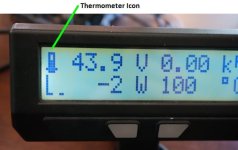You are sort of mixing up operating modes - I know - it's confusing...marcn said:We're using an Aux Pot, and would like to have it control the PAS level when we're using AutoTorqPAS. Is this possible, and if so how would it work in relation to the tables found on page 52 and 53 of the guide?
For example, at <=55RPM we would like 500w, and upto 90RPM, 1000w.
Can we use the 5k potentiometer to adjust these values on the fly from 0,0 to 500,1000w, once we've set the max limits (by inputting trqscale, asstfactr and asststart)?
Edit: Just read that the potentiometer input would only change the AsstFactr, and using AutoTorqPAS would have no effect. Is this correct?
- If you put the pot on AuxPot and configure it for PAS, then it can be used to adjust the assist level 0-100%. When you pedal you get the fixed assist assist power set by the pot.
- AutoTorqPAS is unrelated and is a hack that gives RPM-scaled assist by from a simple PAS wheel. The PAS wheel supplies the RPM information and a fixed voltage from the CA supplies a fixed phoney 'rider pedal torque' signal. This allows us to configure the CA for a torque BB and use the RPM scaling that comes with that kind of device - even though there is no real torque sensing. So - you use the table to make the settings (in your case for 500W/1000W you use the 500W/x2.0 cell). It works like the first case above except the faster you pedal the more assist you get.
- There is another variation that uses a pot with AutoTorqPAS where you INSTEAD wire the pot according to "6.6 PAS Assist Control without AUX Pot – DIY Virtual Torque Sensor". In this case the pot supplies a variable instead of fixed 'phoney rider pedal torque'. You adjust the 'assist' level NOT by using AuxPot, but rather by adjusting the phoney 'rider torque' pot on the PAS 'TRQ' input. This is not basic AutoTorqPAS - it's a variation...
In this 'variation' scheme AuxPot is not involved in any way and you can use it for a three speed switch (Max Current Limiter, preset switcher, or whatever) as you choose. For example it might be configured as a three speed switch limiting Current so the switch would control the max current using the throttle and the pot would control the assist power from PAS. In either case you can flick the switch or turn the pot on the fly.
I use AutoTorqPAS with the 'virtual torque sensor pot' setup on my bike. As I adjust the PAS-pot upwards I can see the power go up on the main screen. I can also flip the 3-position switch and the new AuxPot throttle current limit briefly displays on the screen. So I might be pedaling along on PAS with the throttle current turned down for bike path level power and see a hill coming up. I can downshift to increase my cadence to get more power, or turn up the pot to get more assist, or just flick up the 3 position switch to turn up my available throttle power so I can just goose it over the rise without messing with the assist and gears....
In any case, I recommend that you arrange the pot so it can be manipulated easily to tweak the assist setting - preferably without releasing the grip (at least keep it toward the grip and away from the stem). This is particularly handy if you are trying to match speed with another rider. For example, Here's a post on using a modified thumb throttle for aux pot input or see my build thread for a bar-end pot mount, or I think Kepler has thumb pot setup on one of his bikes - lots of options...


